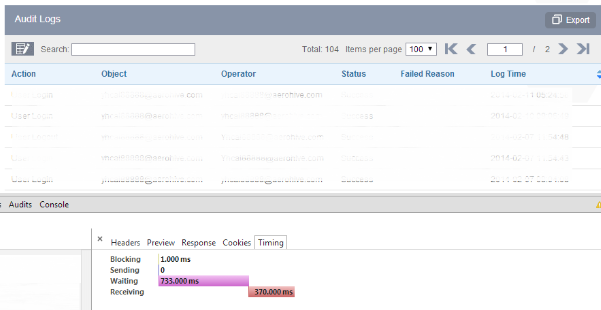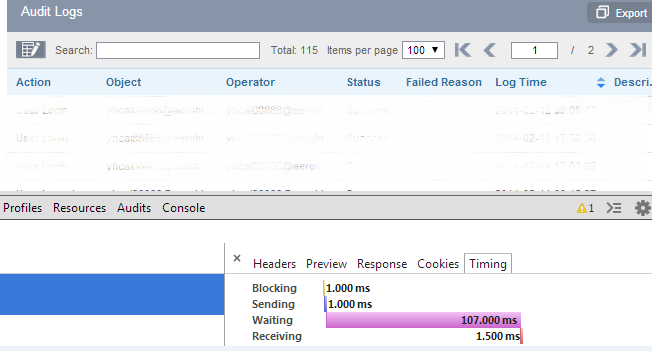First a brief introduction to the dev environment.
Frameworks adopted include spring3.0, shiro, and MemCache that caches web app sessions. MemCache lies at a remote server.
A performance issue is countered with fmt:message in a jsp loop.
Consider the following jsp snippet that does i18n with fmt:message
<c:forEach var= "item" items ="${logs}" varStatus="rowstat" >
... ...
<fmt:message key= "action.key.${item.actionName}" var="actionName" /><span title= '${actionName} '>${actionName} </span>
... ...
</c:forEach>
Deployed in tomcat, and look into its corresponding java file translated by jasper, you would see a function defined for this fmt:message tag as below.
private boolean_jspx_meth_fmt_005fmessage_005f0(javax.servlet.jsp.tagext.JspTag_jspx_th_c_005fforEach_005f0, javax.servlet.jsp.PageContext _jspx_page_context,int[] _jspx_push_body_count_c_005fforEach_005f0)
throwsjava.lang.Throwable {
javax.servlet.jsp.PageContext pageContext =_jspx_page_context;
javax.servlet.jsp.JspWriter out =_jspx_page_context.getOut();
// fmt:message
org.apache.taglibs.standard.tag.rt.fmt.MessageTag _jspx_th_fmt_005fmessage_005f0= (org.apache.taglibs.standard.tag.rt.fmt.MessageTag)_005fjspx_005ftagPool_005ffmt_005fmessage_0026_005fvar_005fkey_005fnobody.get(org.apache.taglibs.standard.tag.rt.fmt.MessageTag.class);
_jspx_th_fmt_005fmessage_005f0.setPageContext(_jspx_page_context);
_jspx_th_fmt_005fmessage_005f0.setParent((javax.servlet.jsp.tagext.Tag)_jspx_th_c_005fforEach_005f0);
///WEB-INF/view/log/userLogAjaxList.jsp(9,8) name = key type = null reqTime =true required = false fragment = false deferredValue = false expectedTypeName =null deferredMethod = false methodSignature = null
_jspx_th_fmt_005fmessage_005f0.setKey((java.lang.String)org.apache.jasper.runtime.PageContextImpl.proprietaryEvaluate("action.key.${item.actionName}",java.lang.String.class, (javax.servlet.jsp.PageContext)_jspx_page_context,null, false));
///WEB-INF/view/log/userLogAjaxList.jsp(9,8) name = var type = java.lang.StringreqTime = false required = false fragment = false deferredValue = falseexpectedTypeName = null deferredMethod = false methodSignature = null
_jspx_th_fmt_005fmessage_005f0.setVar("actionName");
int _jspx_eval_fmt_005fmessage_005f0=_jspx_th_fmt_005fmessage_005f0 .doStartTag();
if (_jspx_th_fmt_005fmessage_005f0.doEndTag() ==javax.servlet.jsp.tagext.Tag.SKIP_PAGE) {
_005fjspx_005ftagPool_005ffmt_005fmessage_0026_005fvar_005fkey_005fnobody.reuse(_jspx_th_fmt_005fmessage_005f0);
return true;
}
_005fjspx_005ftagPool_005ffmt_005fmessage_0026_005fvar_005fkey_005fnobody.reuse(_jspx_th_fmt_005fmessage_005f0);
return false;
}
--------------------------------------------------------------------------------------------------------------
Generally speaking, jstl tags tend to be insufficient compared to lightweight user scriptlet, due to their sophisticated implementation.And in this case, to make things worse, tag class MessageTag accesses session attribute "javax.servlet.jsp.jstl.fmt.localizationContext.session” each time doEndTag is invoked to check localization settings. As mentioned before, session is retrieved from MemCache at a remote server, and each communication costs 3-5 ms in my local env. For100 items, total time cost sums up to around 400ms.
To improve performance, the i18n job is done at spring controller, where locale is read directly from http request.
A couple of pics comparing the performances.
The page displays 100 items and cost 1100ms or so for each data request. Time decreases to about 110ms by merely moving i18n to backend.
/























 9631
9631

 被折叠的 条评论
为什么被折叠?
被折叠的 条评论
为什么被折叠?








